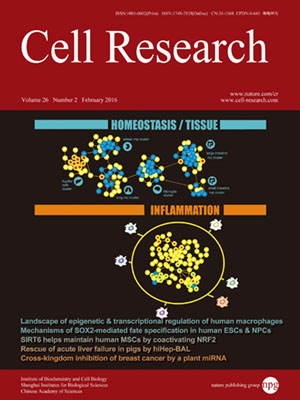
Volume 26, No 2, Feb 2016
ISSN: 1001-0602
EISSN: 1748-7838 2018
impact factor 17.848*
(Clarivate Analytics, 2019)
Volume 26 Issue 2, February 2016: 262-265
LETTERS TO THE EDITOR
Monocyte-derived Wnt5a regulates inflammatory lymphangiogenesis
Roberto Sessa1,2, Don Yuen1,2, Stephanie Wan1,2, Michael Rosner1,2, Preethi Padmanaban1,2, Shaokui Ge2, April Smith3, Russell Fletcher4, Ariane Baudhuin-Kessel4, Terry P Yamaguchi5, Richard A Lang3 and Lu Chen1,2
1Vision Science Graduate Group, University of California, Berkeley, CA, USA
2Center for Eye Disease and Development, Program in Vision Science, and School of Optometry, University of California, Berkeley, CA, USA
3Visual Systems Group, Cincinnati Children's Hospital Medical Center, Cincinnati, OH, USA
4Department of Molecular and Cell Biology, University of California, Berkeley, CA, USA
5Center for Cancer Research, National Institutes of Health, Frederick, MD, USA
Correspondence: Lu Chen, Tel: +1-510-642-5076(chenlu@berkeley.edu)
Lymphatic research signifies a field of explosive discovery in recent years1,2,3. The lymphatic network penetrates most tissues in the body and its dysfunction has been found in a broad spectrum of disorders from inflammation to cancer metastasis and transplant rejection. However, to date, there are few effective treatments for lymphatic diseases. It is therefore important and urgent to investigate the fundamental mechanisms of pathological lymphangiogenesis (LG, the formation of new lymphatic vessels) for the development of new therapeutic strategies. The cornea offers an ideal site for pathological LG research due to its transparent nature and inducible LG3. Since there are no pre-existing or background vessels to consider, it is exceptionally straightforward and accurate to assess LG in response to a pathological insult, such as inflammation.
10.1038/cr.2015.105
FULL TEXT | PDF
Browse 1798


